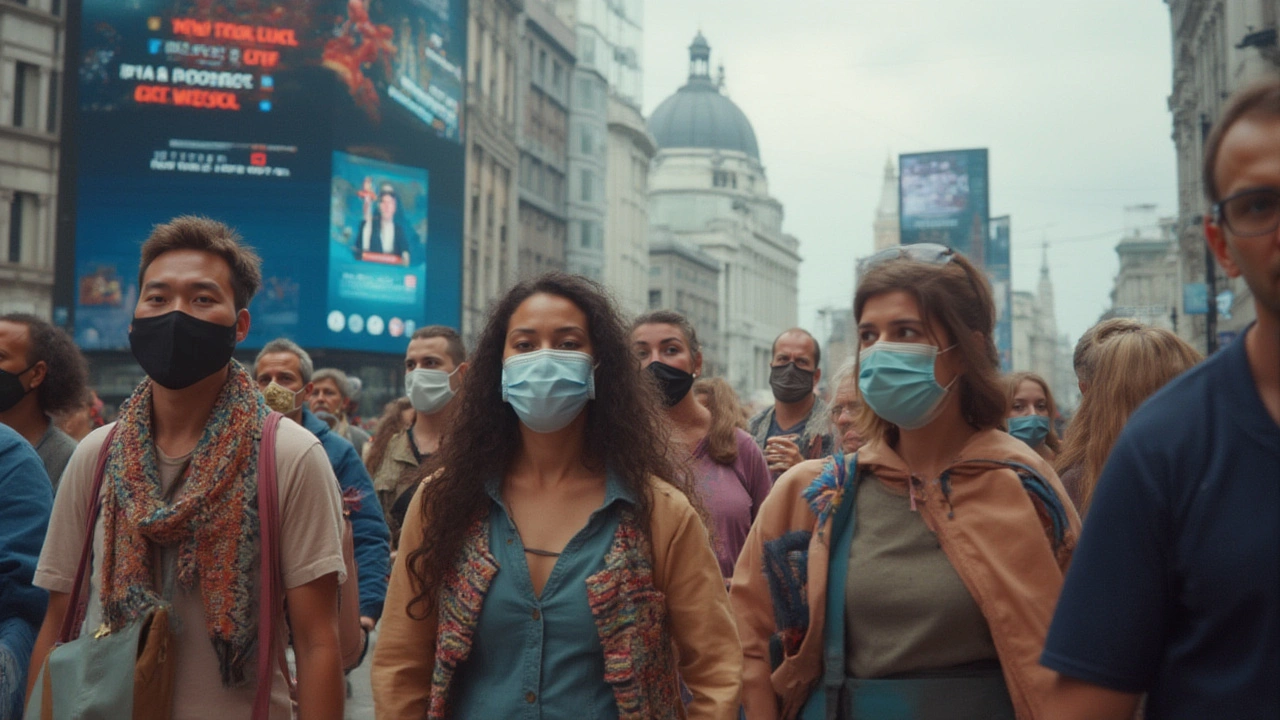
Have you noticed it lately? Railway stations packed, airports busy with summer holiday crowds, but over there you'll spot the coughs, the tissues, the odd sneezing fit. Unlike two years back, hardly anyone is masked up, and fewer carry around those little bottles of sanitizer. Yet, COVID isn't done with the UK—or the world—just yet. July 2025 has brought a fresh wave, and a brand-new variant is on everyone's mind. Yes, the word 'variant' is getting stale, but what’s happening now is anything but predictable. Let’s get right into what’s circulating, how risky it is, and why health officials are watching it closer than ever.
What’s the Current COVID Variant in the UK?
The term everybody is whispering right now is “FLiRT-25” (unofficial name), which has been officially designated as EG.9.3 by the UK Health Security Agency. This is a direct descendent from the Omicron lineage, with a couple of nasty tricks up its sleeve. EG.9.3—or “FLiRT-25”, as you’ll hear in the news— started cropping up in late spring 2025, and by June it became the dominant strain across England, Scotland, and Wales, according to the latest UKHSA variant surveillance reports released mid-June. Forget earlier names like Kraken or Pirola; FLiRT-25 outpaces both in the 'number of cases per week' race.
This new variant has developed a handful of tweaks in its spike protein. Why does that matter? Basically, it means that prior immunity—whether from last winter’s booster or a past infection—doesn’t block this version quite as well. Hospital admissions last week hit 2,700 in England, about a 15% jump compared to mid-May. Lab tests show some people are getting reinfected just four months after a previous bout. If you thought one-and-done when it came to COVID, think again. Interestingly, people who’ve kept up with the 2024 boosters are generally seeing milder symptoms and recovering at home.
One unexpected twist: wastewater data (yes, it's a real thing—scientists literally track virus levels in city sewers) show COVID FLiRT-25 copies are spreading fastest in Greater Manchester, Birmingham, and parts of London, a pattern echoing back to those first-wave hotspots from 2020. Genomic sequencing data from UKHSA labs reveal EG.9.3 now accounts for almost 70% of all positive tests. If you’re following the viral genetics, you’ll notice three key mutations are getting special mention in scientific circles, named L486F, S494P, and R346T. These tweaks allow the virus to latch onto human cells a bit more efficiently, which partly explains why infections keep climbing even with decent vaccine uptake.
| Variant Name | UK % of New Cases | Key Mutations | First Detected |
|---|---|---|---|
| EG.9.3 “FLiRT-25” | 69.7% | L486F, S494P, R346T | April 2025 |
| JN.1 “Pirola” | 13.1% | R346T, E484K | Nov 2024 |
| BA.2.86 “Kraken” | 6.3% | N460K, G446S | July 2024 |
| Other | 10.9% | Various | — |
With these numbers, it’s plain to see why public health authorities are raising renewed warnings, even pushing for targeted vaccinations again for those most at risk—over 65s and people with immune problems.
Symptoms and What Makes FLiRT-25 Different?
So, what can you expect if you catch FLiRT-25? This strain is especially sneaky. About half of infected people start off with what feels like a minor summer cold—scratchy throat, a sniffle, mild headache. But here’s where it gets odd: persistent cough is back (just when people had stopped worrying about it), and 1 in 5 cases report a sudden loss of smell or metallic taste, which had dropped off with previous Omicron versions. Some people report tummy upset, muscle aches, and straight-up exhaustion within 36 hours. Night sweats seem to pop up much more now, according to recent NHS digital symptom tracking. Fever is less common, but chest tightness is creeping back up. Kids often shrug off the worst of it, but folks in their 50s and up are ending up in hospital beds a bit more than last summer.
Compared to, say, Delta or the first Omicron, EG.9.3 hasn’t shown much higher risk for severe pneumonia, but it lingers. Some unlucky folks are still coughing four weeks after their positive test. And, yes, the "brain fog" and fatigue hangover are showing up again, with almost 14% of patients in one Manchester GP practice reporting symptoms lasting a month or more. If you’re a long-hauler, none of this will surprise you. The curious part about *this* variant is how it ducks certain antibodies but not others—the vaccine-induced ones still tackle it, but you’ve got to be up to date. 2024 was not the year to skip your shots.
Here are the most reported symptoms, per NHS and UKHSA data:
- Persistent dry cough (reported in 64% of new cases)
- Runny or blocked nose
- Sore throat
- Unusual fatigue (even after sleeping)
- Metallic taste or loss of smell/taste
- Night sweats
- Stomach cramps or nausea (especially in younger adults)
- Joint pains, sometimes severe
- Shortness of breath or chest tightness
The bottom line: FLiRT-25 is agile, a bit more in-your-face with certain symptoms, and its longer recovery times make it more disruptive for work and travel than most expected. If you get sick, expect a bumpy ride for at least a week, and keep an eye on the more unusual signs—especially if you’re older or have chronic conditions.

How Fast Is FLiRT-25 Spreading and Who’s at Risk?
Speed matters—and this one is setting records for the summer season. UKHSA published figures last week showing test positivity rates jumping to 18.4% in cities, almost double what was seen during last July. Hospital admissions have ticked up by 22% for the over-65s in the past four weeks. More care home outbreaks are getting flagged, especially in the north. If you’re out and about, especially in busy indoor places, the numbers say you’re a lot more likely to rub elbows with someone infectious.
Travel is helping FLiRT-25 spread far and wide. With restrictions pretty much gone, London airports logged over 9 million passengers in June alone, the highest since 2019. Add in the music festivals, Wimbledon crowds, and bustling seaside resorts, and you’ve got a perfect storm for viral spread. NHS Test and Trace (yes, it still exists, though you hardly hear about it) logged over 154,000 new positive cases the last week of June, the highest since the previous winter. It’s not just numbers—real lives are getting upturned. Some workplaces are quietly shifting back to hybrid models, at least for July, and schools in hotspot areas like Birmingham and Manchester have reintroduced “stay-home if sick” guidance for pupils and teachers.
So, who’s at serious risk? Most healthy teens and young adults barely register more than a bad cold, but the numbers change fast if you’re over 60, living in a care home, or dealing with weakened immunity. Here’s what stands out in NHS stats:
- People with underlying lung or heart conditions: ICU admissions are up 31% in this group compared to last month.
- Immunocompromised patients: Longer illness, risk of secondary infections, and slower recovery.
- Pregnant women: Most stay out of hospital, but flu-like symptoms hit harder; the JCVI is urging boosters for this group before autumn.
- Children under 5: Hospitalisation rates remain low, but keepers at children’s hospitals note a bump in dehydration and breathing issues, mostly in toddlers with other illnesses.
One more odd bit: workplaces with poor ventilation—think windowless offices, crowded call centres—report way higher rates of clusters. In fact, a University of Leeds analysis of public and commercial buildings across Greater Manchester found CO2 levels (a stand-in for poor ventilation) lapped the UK safety recommendations in 41% of shops and offices last month. So if you work somewhere stuffy, keep those windows open whenever you can.
Should You Be Worried About Travel and Public Events?
This summer is supposed to be about concerts, food festivals, and football – but every event organiser now dreads a “superspreader” headline. Are people freaking out? Not really, at least openly. But those planning a trip or big event want the lowdown on risks.
Flights are running near pre-pandemic capacity, yet most airlines just make a nod towards mask-wearing. If you’re flying out of Gatwick, Stansted, or Heathrow, you’re bumping shoulders with travelers from every hotspot in Europe and beyond. Does this make a huge difference? Absolutely—UKHSA flagged 680 new imported FLiRT-25 cases last week alone, most from short-haul trips to Spain, Greece, and Turkey. Add in UK holidaymakers heading abroad every day, and it’s no wonder cases spike every time school holidays kick off.
Festivals aren’t much better—the first Glastonbury data trickled in showing a mild post-event bump in cases, especially among under-40s. The good news: big outdoor events still carry less risk than indoor ones, but shared tents and crowded shuttle buses bring the odds right back up. University open days, job fairs, and weddings are also quietly flagged as higher-risk. NHS COVID app usage is at its lowest since 2022, meaning lots of people don’t even realize they’ve been exposed until symptoms hit.
What about holidays at home? Think coastal towns, lakes, summer sports camps. Local GPs are warning about isolated outbreaks in busy campsites and family resorts, especially those with indoor play areas. If you plan a “staycation” in July, experts suggest carrying at-home testing kits (still widely available online), packing backup masks, and keeping medicine cabinet basics in your suitcase—paracetamol, cold and flu meds, and a thermometer or pulse oximeter for peace of mind. Don’t let paranoia ruin your trip, but a bit of extra prep can mean a less stressful holiday if you or your travel mates start feeling rough.
One surprising tip: multiple studies in June revealed that keeping good airflow—like bringing a small battery-powered fan or propping windows—cuts risk by roughly 30% in shared spaces. So, whether it’s a trip to the cinema, the local gym, or your cousin’s wedding, don’t ignore how stuffy the venue feels.

Tips for Protecting Yourself and Others (Yes, They Still Matter)
If you’re sick of pandemic advice, that makes sense. But new waves call for a bit of old-school wisdom, maybe minus the total lockdown. FLiRT-25 is slippery, but it’s still beatable with some simple habits. Here’s what works, July 2025 edition:
- covid variant UK: Keep up to date with local variant news. UKHSA’s website releases weekly variant summaries, as do major newspaper sites.
- If you’re eligible for a COVID booster shot (check with NHS or your GP for latest cutoff), book it. New bivalent boosters target EG.9.3 these days, and there’s real world data to show they slash your risk of a hospital visit.
- Testing isn't dead! NHS rapid test kits can still be requested online, and pharmacies stock them. If you feel even slightly off—runny nose, mild cough, new fatigue—take a test, especially before seeing vulnerable relatives.
- Fresh air matters more than you think: open windows, sit by outdoor tables, or turn on the extractor fan in tiny spaces.
- Masks: not required by law, but smart for buses, trains, or office lifts. N95/FFP2 types bring the best protection, but even a simple medical mask helps in a pinch.
- Hand hygiene: not just a pandemic holdover. FLiRT-25 does survive longer on hands than most prior Omicron variants. Use sanitizer or wash up—especially before eating or touching your face.
- If you’re organizing an event or meet-up, ask people to stay home if they’re sick. It feels awkward but beats everyone falling ill a week later.
- For anyone with a vulnerable household member, have a “COVID plan”—think isolation room, spare masks, at-home oximeter, and an emergency GP contact handy.
- Stay alert to sudden shifts: NHS will update guidance quickly if hospitalizations hit red alert levels. Apps like BBC News or NHS Digital can ping alerts for your postcode.
The moral? COVID is still the wild card in UK life, and the latest variant, FLiRT-25, is faster on its feet than many expected. But with common sense and updated advice, summer can go on. Swipe right on fresh air, proper vaccination, and planning ahead, and you’ll lower your risk of disruptions—whether it’s work, holidays, or just that weekend barbecue.